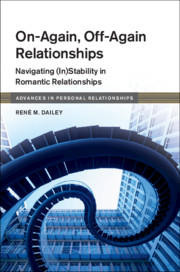Book contents
- On-Again, Off-Again Relationships
- Advances in Personal Relationships
- On-Again, Off-Again Relationships
- Copyright page
- Dedication
- Contents
- Figures
- Tables
- Acknowledgments
- Introduction
- 1 Description and Prevalence of On-Again/Off-Again Relationships
- 2 Differences from Non-Cyclical Relationships
- 3 Explaining On-Again/Off-Again Relationships
- 4 Types and Trajectories of On-Again/Off-Again Relationships
- 5 Breakups, Renewals, and In-Between
- 6 Conceptualizing (In)Stability
- 7 Practical Applications
- 8 Research Agenda
- Epilogue
- Appendix Description of Samples
- Notes
- References
- Index
5 - Breakups, Renewals, and In-Between
Published online by Cambridge University Press: 02 December 2019
- On-Again, Off-Again Relationships
- Advances in Personal Relationships
- On-Again, Off-Again Relationships
- Copyright page
- Dedication
- Contents
- Figures
- Tables
- Acknowledgments
- Introduction
- 1 Description and Prevalence of On-Again/Off-Again Relationships
- 2 Differences from Non-Cyclical Relationships
- 3 Explaining On-Again/Off-Again Relationships
- 4 Types and Trajectories of On-Again/Off-Again Relationships
- 5 Breakups, Renewals, and In-Between
- 6 Conceptualizing (In)Stability
- 7 Practical Applications
- 8 Research Agenda
- Epilogue
- Appendix Description of Samples
- Notes
- References
- Index
Summary
The quintessential feature of on-off relationships is the experience of both breakups and renewals. This chapter reviews how breakups and post-dissolution relationships are different for on-off partners as compared to those who have not experienced a renewal. Few differences emerged between the two relationship types in terms of breakup experiences. However, although on-off partners did not report any greater breakup distress, they did report more contact with their former partners, and did so for reasons related to continued attraction, sexual access, and practical reasons (e.g., having children together) more than non-cyclical partners. Using data that tracked ex-partners for several months, this chapter also reports initial findings on what predicts renewals for those with and without a history of relationship cycling. In general, first renewals were predicted by not wanting the breakup and perceiving a lack of alternatives. Renewals by those already with a history of cycling were predicted by problematic dynamics (e.g., aggression) while dating, post-dissolution sex, and having less negative experiences with the partner after the breakup. The collective of findings suggest reconciliations are best predicted by what happens after the breakup rather than by why or how the breakup occurred.
Keywords
- Type
- Chapter
- Information
- On-Again, Off-Again RelationshipsNavigating (In)Stability in Romantic Relationships, pp. 95 - 112Publisher: Cambridge University PressPrint publication year: 2019



